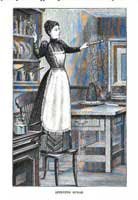 Sugar was heated to "the crack" stage, then from a fork or spoon "rapidly throw it to and fro..." into some elaborate structures...
Sugar was heated to "the crack" stage, then from a fork or spoon "rapidly throw it to and fro..." into some elaborate structures...
Put half a pound of water with one pound of Marshall's cane sugar in a perfectly clean copper sugar-boiler or thick stewpan; cover the pan over, bring to the boil, remove any scum as it rises from time to time, and continue boiling until the liquid forms a thick bubbled appearance (commonly called the crack) ; then take a small portion on a clean knife or spoon (or the finger may be used, but must be well wetted with cold water and used very quickly), aud plunge it immediately into cold water, and if it is then quite brittle and leaves the knife or spoon or finger quite clear it is ready for spinning. If it clings or is at all soft or pliable, continue the boiling until as above. When ready take a small portion on a fork or spoon, and rapidly throw it to and fro over a slightly oiled rolling-pin; continue until sufficient threads of sugar are obtained. [Marshall, Agnes B. Mrs. A. B. Marshall's Larger Cookery Book of Extra Recipes. London: 1902]
Careme had many recipes making use of spun sugar in his section "Of Pieces Montrees" for elaborate centerpieces involving globes, buildings, fountains etc. The roof of the image is spun sugar. [Careme, M.A. The Royal Parisian Pastrycook and Confectioner. London: 1834]
Three recipes from 1769 by Raffald are "To spin a Silver Web for covering Sweetmeats, To spin a Gold Web for covering Sweetmeats, [and] To make a Desert [sic] of Spun Sugar." To make a web or bowl, butter the bottom of an inverted bowl and taking the prepared syrup with a knife tip "...draw as quick as possible backwards and forwards, and also around the Mould, as long as it will spin from the Knife; be very careful you do not not drop the Syrup on the Web..." [Raffald, Elizabeth. The Experienced English House-keeper. Manchester: 1769]
"Temples and pavilions of four to five feet in height can be made; and when the sugar is properly boiled, and in dry weather, this work will keep several days: the author has kept some pieces quite perfect for a month, by excluding them carefully from the air. [Jarrin, William. The Italian Confectioner. London: 1829]
©2011 Patricia Bixler Reber
hearthcook.com




No comments:
Post a Comment